73 - Management of Foreign Bodies of the Airway
Editors: Shields, Thomas W.; LoCicero, Joseph; Ponn, Ronald B.; Rusch, Valerie W.
Title: General Thoracic Surgery, 6th Edition
Copyright 2005 Lippincott Williams & Wilkins
> Table of Contents > Volume I - The Lung, Pleura, Diaphragm, and Chest Wall > Section XIV - Congenital, Structural, and Inflammatory Diseases of the Lung > Chapter 86 - Bacterial Infections of the Lungs and Bronchial Compressive Disorders
Chapter 86
Bacterial Infections of the Lungs and Bronchial Compressive Disorders
Joseph I. Miller Jr.
Suppurative diseases of the lung and certain bronchocompressive disorders formed the basis for the development of thoracic surgery as a separate surgical specialty. Despite the development of antibiotics and newer techniques in diagnosis and management, these disorders continue to form an important part of the specialty of general thoracic surgery. As noted by Hood (1994a), a number of factors contribute to the continued frequency with which these disease entities are seen. These include the emergence of antibiotic-resistant organisms, increased numbers of immunosuppressed individuals, increased drug abuse, increased aging population, and the emergence of nosocomial pulmonary infections.
The prevalence of these conditions requires that the thoracic surgeon have knowledge and surgical skills to handle these disease entities. An outline of the surgical spectrum of bacterial infections and bronchocompressive disorders of the lung is given in Table 86-1.
BRONCHIECTASIS
The term bronchiectasis is derived from the Greek bronchus and ektasis, meaning dilatation. In essence, as pointed out by Hodder and colleagues (1995), the term refers to the abnormal permanent dilatation of subsegmental airways. The history of bronchiectasis parallels that of thoracic surgery and has been outlined previously by Lindskog (1986). The techniques of segmental resection were developed in large part because of this entity. Detailed anatomic descriptions of segmental anatomy by Boyden (1955) led to the development of individual ligation of the hilar bronchovascular structures and significantly decreased postoperative complications. With the development of antibiotics in the 1940s, this entity has not been seen as frequently, but with the emergence of drug-resistant microorganisms and increasing frequency of drug-resistant tuberculosis, an increased incidence of postinfectious bronchiectasis is being noted.
An outline of the etiology of bronchiectasis is given in Table 86-2. Etiologic conditions can be divided into congenital and acquired. The most frequent congenital causes are cystic fibrosis, hypogammaglobulinemia, and Kartagener's syndrome. The most frequent acquired cause is secondary to an infectious process.
Barker (1995) emphasized that the pathophysiology of bronchiectasis requires an infectious process plus impairment of bronchial drainage, airway obstruction, or a defect in host defense. Bronchial obstruction can be caused by foreign body aspiration or enlarged lymph nodes compressing a bronchus, as seen in middle lobe syndrome. Barker (1995) noted that in immunocompromised patients, there may be ciliary dyskinesia, airway immune effector cells, neutrophilic proteases, and inflammatory cytokines. Regardless of the cause, an intense inflammation results in transmural inflammation, mucosal edema, and bronchial neovascularization.
The terms cylindrical, varicose, and saccular have been used to describe the pathology of bronchiectasis. A classification of bronchiectasis is given in Table 86-3. Saccular bronchiectasis follows a major pulmonary infection or results from a foreign body or bronchial stricture and is the principal type of surgical importance. Cylindrical bronchiectasis consists of bronchi that do not end blindly but communicate with lung parenchyma. This is associated frequently with tuberculosis and immune disorders. Hood (1994b) noted a third type referred to as varicose, a mixture of the former two, and is distinguished by alternating areas of cylindrical and saccular disease. Pseudobronchiectasis, a term first reported by Blades and Dugan (1944), is a cylindrical dilatation of a bronchus after an acute pneumonic process that is temporary and disappears in several weeks or months. This type has no surgical implications. In addition, certain genetic syndromes may be associated with some form of bronchiectasis. These include cystic fibrosis, 1-antitrypsin deficiency, and immunoglobulin A (IgA) and IgG deficiency.
Table 86-1. Surgical Spectrum of Bacterial Infections of the Lung and Bronchial Compressive Disease | |
|---|---|
|
Table 86-2. Etiology of Bronchiectasis | |
|---|---|
|
Table 86-3. Classification of Bronchiectasis | |
|---|---|
|
Table 86-4. Anatomic Distribution of Bronchiectasis in Order of Frequency | |
|---|---|
|
Table 86-5. Frequency of Distribution of Bronchiectasis: Area of Involvement | |
|---|---|
|
P.1220
The distribution and frequency of bronchiectasis is given in Tables 86-4 and 86-5. The distribution to some extent is characteristic of the etiology. For example, in patients with Kartagener's syndrome, hypogammaglobulinemia, and cystic fibrosis, the areas of involvement are generally diffuse and bilateral and involve multiple cystic segments of both upper and lower lobes. Tuberculosis is either unilateral or bilateral and generally involves the upper lobes or superior segment of the lower lobes. Middle lobe syndrome is caused by the involvement of lymph nodes and the middle lobe bronchus from a granulomatous process.
Clinical Diagnosis
Clinical bronchiectasis is characterized by repeated episodes of respiratory tract infection. The key symptom is cough with mucopurulent and tenacious secretions lasting months to years. This may be accompanied by intermittent hemoptysis, dyspnea, wheezing, and pleurisy. It is most frequently characterized by clinically repeated episodes.
Methods of Diagnosis
After a thorough history and physical examination, the most frequently used techniques in the diagnosis of bronchiectasis are imaging modalities, fiberoptic bronchoscopy, and bronchograms. Before the advent of computed tomographic (CT) scanning, a bronchogram was the standard procedure for diagnosis (Fig. 86-1). A high-resolution CT scan has replaced this procedure in the diagnosis of bronchiectasis. The detailed images demonstrate bronchial dilatation, peribronchial inflammation, and parenchymal disease. According to Barker (1995), the diagnosis can be made with a 2% false-negative and a 1% false-positive rate. Figure 86-2 shows a typical high-resolution CT scan for lower lobe bronchiectasis.
Treatment of Bronchiectasis
An outline for the medical and surgical management of bronchiectasis is given in Table 86-6. The goals of medical management include prevention and control, appropriate antibiotic therapy, and postural drainage.
 |
Fig. 86-1. Bilateral saccular bronchiectasis, characteristic of the preantibiotic era, involving the lower lobes, lingula, and right middle lobe. From Ferguson TB, Burford TH: The changing pattern of pulmonary suppuration: surgical implications. Dis Chest 53:396, 1968. With permission. |
P.1221
Surgical management of bronchiectasis has strict limitations and guidelines. Surgical treatment is based on three premises: (a) the disease is segmental and unilateral, (b) complete resection of all disease is possible, and (c) complete resection of all disease prevents recurrence. This does not apply to those patients with immunologic or genetic abnormalities. Specific surgical indications are listed in Table 86-6. The immediate goal of surgical resection is the removal of most, preferably all, involved segments or lobes and preservation of nonsuppurative areas. The results of surgical resection for bronchiectasis are given in Table 86-7. Hodder and associates (1995) reported that the mortality rates vary from 0% to 8.3%.
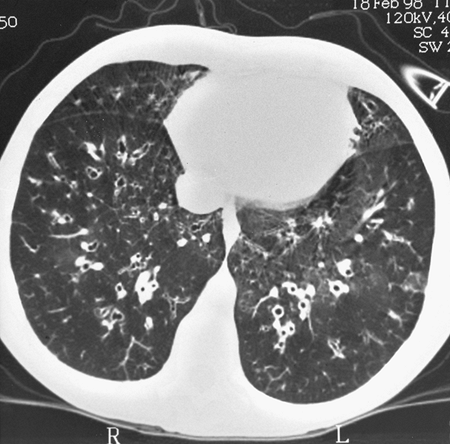 |
Fig. 86-2. High-resolution computed tomographic scan of bronchiectasis. |
Table 86-6. Treatment of Bronchiectasis | |
|---|---|
|
Lung transplantation may be performed for patients with suppurative lung disease. Barker (1995) noted that of 3,160 lung transplants reported by the St. Louis Lung Transplant Registry in 1994, 466 patients underwent transplantation for cystic fibrosis and 82 for bronchiectasis. The actuarial survival rate for patients with cystic fibrosis is 72% at 1 year and 57% at 3 years.
LUNG ABSCESS
Lung abscess has been recognized since the time of Hippocrates; Wiedemann and Rice (1995) quote Hippocrates:
As time goes by, the fever becomes more severe, coughing begins, and the patient cannot lie any more on the healthy side but only on the diseased side. The feet and eyes swell. When the 15th day after the rupture has occurred, prepare a warm bath, sit him upon a stool, shake him by the shoulders and listen to where the noise is heard. At that place, make an incision then it produces death more rarely.
Before the antibiotic era, it was realized that unless drainage was achieved, death was inevitable. With the development of antibiotics, treatment improved and mortality
P.1222
decreased. With the development of increasing numbers of immunosuppressed individuals and the increased incidence of nosocomial pneumonia, lung abscess continues to be a problem for practicing thoracic surgeons.
Table 86-7. Results of Surgical Resection for Bronchiectasis | ||||||||||||||||||||||||
|---|---|---|---|---|---|---|---|---|---|---|---|---|---|---|---|---|---|---|---|---|---|---|---|---|
| ||||||||||||||||||||||||
Table 86-8. Classification of Lung Abscess | |
|---|---|
|
Geppert (1994) defines a lung abscess as a subacute pulmonary infection in which the chest radiograph shows a cavity within the pulmonary parenchyma. It is a localized collection of pus that is contained within the cavity formed by the disintegration of the surrounding tissues. An abscess is defined as acute when the duration of symptoms is less than 6 weeks. In general, the abscess is solitary, but occasionally may be multiple, particularly in the immunocompromised individual.
A classification of lung abscess is given in Table 86-8. Contributing factors to the development of a lung abscess are listed in Table 86-9. Anaerobic infections remain the most frequent etiologic agents. Periodontal disease and aspiration are the two most frequent causes. Fewer than 20% of patients with an anaerobic lung abscess do not have a history of one or the other of these aforementioned causes.
The typical patient has a history of an antecedent event or history of pulmonary infection or pneumonia. Patients have an intermittent febrile course with weight loss, night sweats, and cough. Later in its course, the production of purulent sputum becomes quite common. The patient may have foul breath and often appears quite ill.
The most frequent microorganisms associated with lung abscess are listed in Table 86-10. The microorganism is most likely related to the etiologic cause. The most frequent anaerobic cause is Bacteroides and the most frequent aerobic causes are Staphylococcus aureus and Streptococcus pneumoniae.
Table 86-9. Contributing Factors to Lung Abscess | |
|---|---|
|
Table 86-10. Bacteriology of Lung Abscess | |
|---|---|
|
Diagnostic techniques include a complete history and physical examination with emphasis on a predisposing event such as dental work or possible aspiration. The symptoms of fever and purulent foul-smelling sputum are highly suggestive. Analysis of the sputum is necessary in the attempt to identify the causative microorganism.
Fiberoptic bronchoscopy is indicated for two reasons. It helps in the bacteriologic assessment with the use of a sterile brush and in obtaining bacterial washings for bacterial analysis. It is also important to rule out an endobronchial tumor or obstruction and determine if the abscess is draining internally.
Radiographic imaging is generally required to determine for certainty the presence of a lung abscess. Posteroanterior and lateral chest radiography and CT scanning of the chest are the most frequent modalities used (Figs. 86-3 and 86-4). The most frequent sites of involvement are in the superior segments of the right and left lower lobes and the lateral part of the posterior segment of the right upper lobe (the axillary subsegment) (Fig. 86-5). Ninety-five percent of all lung abscesses occur in these locations.
The differential diagnosis of cavitary lung lesions revolves around four entities: (a) cavitating carcinoma, generally squamous cell; (b) tuberculous or other fungal diseases; (c) pyogenic lung abscess; and (d) empyema with bronchopleural fistula. The patient's history is important in separating the differential diagnosis. Hood (1994a) suggested that the absence of fever, lack of purulent sputum, and a normal white blood cell count should make one highly suspicious of an underlying neoplasm.
Once the diagnosis is established, appropriate therapy must be instituted. Principles of therapy are given in Table 86-11. The etiologic organisms must be identified as quickly as possible through the techniques previously discussed. Appropriate antibiotics should be instituted based on drug sensitivity. If an aerobic microorganism is suspected, the patient is generally started on clindamycin and gentamicin while awaiting sensitivity study results. Antibiotics are continued for a prolonged period, generally 6 to 8 weeks.
Adequate drainage must be achieved by chest physiotherapy, fiberoptic bronchoscopy, or percutaneous catheter drainage. Only when the abscess does not drain internally
P.1223
into the tracheobronchial tree is external drainage indicated. Wiedemann and Rice (1995) reported that 80% to 90% of aerobic lung abscesses respond to medical therapy.
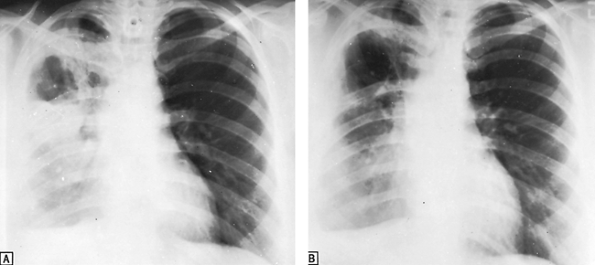 |
Fig. 86-3. A. Lung abscess of the preantibiotic era involving the right upper lobe. The abscess followed tonsillectomy. B. Same patient 3 weeks later showing spread to the left lung. From Ferguson TB, Burford TH: The changing pattern of pulmonary suppuration: surgical implications. Dis Chest 53:396, 1968. With permission. |
When the abscess does not drain internally and the patient experiences a septic course, external drainage can be achieved by closed tube thoracostomy, CT-directed catheter drainage, or pneumonostomy (Fig. 86-6).
Development of percutaneous catheter drainage has significantly improved the treatment of patients with a lung abscess and decreased the need for surgical intervention. The procedure can be performed with low morbidity and mortality. Occasionally, it may be used to prepare a septic patient for surgery. The results from some published series are presented in Table 86-12. Although generally avoidable, surgical resection may be required in up to 30% of patients undergoing percutaneous catheter drainage.
Surgical intervention is now required in only approximately 10% of patients with lung abscess. The indications for surgery in lung abscess are listed in Table 86-13. Specific indications include unsuccessful medical management over a period of 8 weeks; suspicion of cancer; complication of lung abscess, such as empyema or bronchopleural fistula; persistence of a cavity larger than 6 cm after 8 weeks of treatment; and the presence of massive hemoptysis. An algorithm for the management of lung abscess is given in Fig. 86-7.
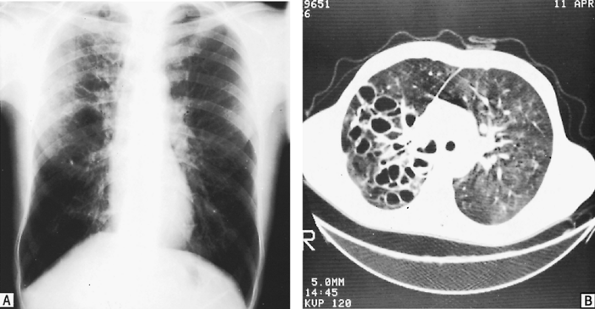 |
Fig. 86-4. A. Posteroanterior chest radiograph of a patient admitted with a lifelong history of pulmonary infection and hemoptysis demonstrates extensive cystic disease of the right lung. B. A computed tomographic film clearly illustrates the cystic nature of the bronchiectasis. From Hood RM: Bacterial infections of the lungs. |
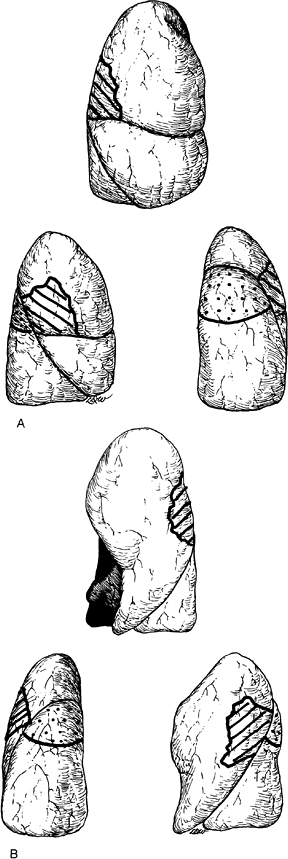 |
Fig. 86-5. Axillary subsegment of the posterior segment at the upper lobe and superior segment of the lower lobe. A. Right lung. B. Left lung. From Hood RM: Bacterial infections of the lungs. |
Table 86-11. Principles of Therapy for Lung Abscess | |
|---|---|
|
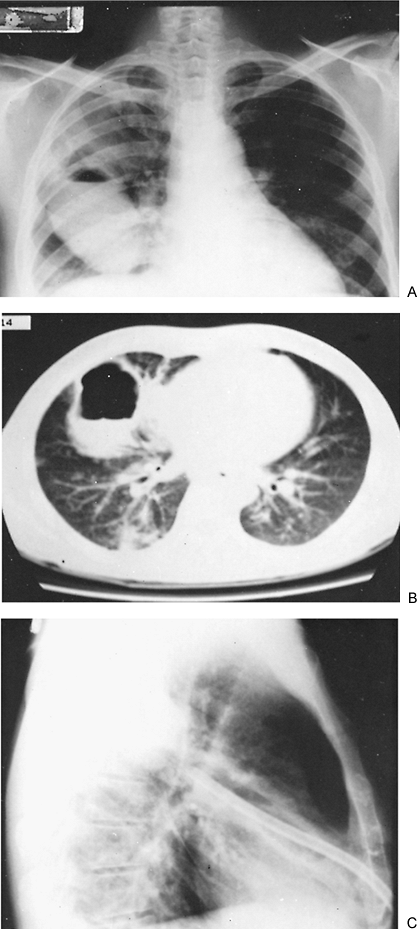 |
Fig. 86-6. Anteroposterior view of a patient with a large aspiration abscess of the middle lobe. Poor bronchial drainage exists, and the patient was toxic. B. Computed tomographic examination of the patient. C. Lateral view after Monaldi drainage. The patient recovered. This patient was unresponsive to antibiotic therapy and shows the occasional need for surgical drainage. This patient was admitted in 1984. From Hood RM: Bacterial infections of the lungs. |
Table 86-12. Percutaneous Catheter Drainage of Lung Abscess | |||||||||||||||||||||||||||||||||||||||||||||||||
|---|---|---|---|---|---|---|---|---|---|---|---|---|---|---|---|---|---|---|---|---|---|---|---|---|---|---|---|---|---|---|---|---|---|---|---|---|---|---|---|---|---|---|---|---|---|---|---|---|---|
| |||||||||||||||||||||||||||||||||||||||||||||||||
P.1224
P.1225
BACTERIAL INFECTIONS OF SURGICAL IMPORTANCE IN IMMUNOSUPPRESSED PATIENTS
Bacterial infections in immunocompromised individuals continue to present problems to the general thoracic surgeon. They continue to be a major source of morbidity and mortality. These individuals are susceptible to a wide variety of organisms, but specific infections tend to occur in well-defined settings. The type of infection can be predicted based on the nature and severity of the immune defect, past patient exposures, chemotherapy given, radiographic presentation, and acuteness of illness. New treatments with oral antifungal agents and antiviral agents have improved some of the infectious complications, but in selected cases the definitive attention of the general thoracic surgeon is still needed. The general thoracic surgeon is most frequently consulted for management of pneumothoraces, need for open lung biopsy, particularly in the immunocompromised patient with bilateral infiltrates, and management of bacterial and fungal complications such as hemoptysis. The most common immunologic defects and infectious organisms are listed in Table 86-14.
Pneumothorax
The majority of pneumothoraces in immunocompromised individuals can be handled with closed tube thoracostomy and an experienced general thoracic surgeon competent in the management of prolonged air leaks. The majority of these pneumothoraces occur in immunocompromised individuals infected with human immunodeficiency virus. During the early and mid-1980s, I operated on a significant number of immunocompromised individuals with human immunodeficiency virus. Beginning in 1990, I began to use the Heimlich valve in the control of pneumothoraces combined with talc sclerosis. My group has treated more than 150 individuals since 1990, with none requiring further surgical intervention. Essentially any leak that occurs in an immunocompromised individual can be handled by this technique. This chapter does not permit a detailed analysis of the tricks of tube management.
Table 86-13. Indications for Surgery in Lung Abscess | |
|---|---|
|
Open Lung Biopsy or Thoracoscopic Biopsy
The thoracic surgeon is often called to see an immunocompromised patient who is on a ventilator and in whom the
P.1226
pulmonologist has exhausted all interventions short of open lung biopsy to establish a diagnosis. In this situation, open lung biopsy is frequently indicated. In the emergency situation, the video-assisted thoracic surgery (VATS) technique should not be used, but a 20-minute open procedure with conventional ventilation is most likely to yield a diagnosis in the most cost-efficient manner. It should also be stated that in my 25 years of experience with open lung biopsy on bone marrow transplant patients, not one patient has survived nor has open lung biopsy changed the postoperative course (see also Chap. 94).
 |
Fig. 86-7. Algorithm for management of lung abscess. CT, computed tomography; CXR, chest x-ray; PT, pneumothorax. |
Table 86-14. Immunologic Defects and Infectious Complication in Immunosuppressed Individuals | ||||||||||
|---|---|---|---|---|---|---|---|---|---|---|
| ||||||||||
Surgery
The third scenario in which the general thoracic surgeon is contacted to see an immunocompromised patient is when significant hemoptysis has developed. In this situation, the surgeon's role is to localize the site of hemoptysis through bronchoscopy and CT scanning. Once identified, bronchial embolization with gel foam or coils should be performed. In the majority of patients, this controls the hemoptysis.
The other situation in which surgery may be readily indicated is in the patient with hemoptysis secondary to infection with aspergillosis in the fungal cavity. Another situation is the immunocompromised patient with diabetes mellitus who is infected with mucormycosis. In this case, surgical resection of the affected lung parenchyma may be the only chance for survival in these immunocompromised patients despite therapy with amphotericin B.
ORGANIZING PNEUMONIA
An occasional patient with pneumonitis, even with appropriate antibiotic therapy, does not follow the usual predictable course and develops an organized pneumonic process. This also is seen in some patients who receive little or no therapy. The course varies considerably, but the infectious process resolves into a protracted chronic course, and little or no resolution is seen on chest radiography. The volume usually slowly decreases and may even progress to complete atelectasis of the involved area. Hood (1994a) noted that the process may be either lobar or segmental in extent. Pathologically, the involved area is airless and densely fibrotic, with bronchial distortion or bronchiectasis (see Fig. 86-8). Microscopically, the lung structure is destroyed.
The lesion must be differentiated from an obstructing carcinoma, primary pulmonary tuberculosis, mycotic infection, foreign body aspiration, mucoid impaction, or lipoid pneumonia, among other chronic processes. Hood (1994b) noted that lipoid pneumonia may be exogenous from aspiration of mineral oil or may be endogenous lipoid pneumonia resulting from some inflammatory or toxic injury to the lung (Fig. 86-9).
Regardless of its cause, the area of organized pneumonia should be resected. The outcome is satisfactory in nonimmunocompromised
P.1227
patients, but is poor in the immunocompromised host.
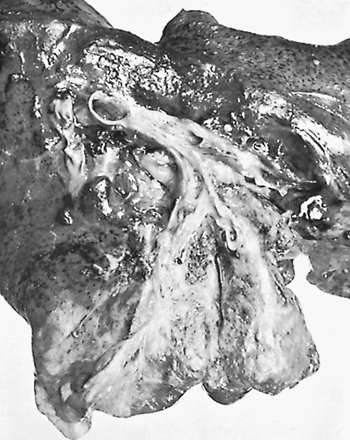 |
Fig. 86-8. Right lower lobe resected for organizing pneumonia shows extensive replacement of the parenchyma by scar tissue. From Hood RM: Bacterial infections of the lungs. |
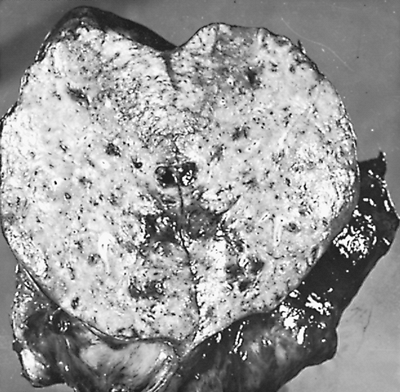 |
Fig. 86-9. Gross specimen of lobe removed in the treatment of lipoid pneumonia. From Hood RM: Bacterial infections of the lungs. |
PULMONARY INFECTIONS IN CHRONIC GRANULOMATOUS DISEASE OF CHILDHOOD
Chronic granulomatous disease is a rare genetically transmitted disease in which the host's phagocytes are unable to respond to stimuli with a normal respiratory burst (i.e., production of superoxide and hydrogen peroxide by the nicotinamide adenine dinucleotide phosphate oxidase systems). The normal respiratory burst leads to the killing of ingested microorganisms. Recurrent severe infections with common as well as with catalase-positive organisms occur. Fungal infections are frequent. The lung is the most common site of infection, and pulmonary suppuration is the cause of death in more than half of children with chronic granulomatous disease.
Clinical Course
Initial pulmonary infections occur in early childhood, but the diagnosis of the underlying process is usually not made until several years later. Chronic, repeated infections and, ultimately, death in the first or second decade of life were the usual course of the disease until the use of routine prophylaxis with antibiotics. The use of trimethoprim-sulfamethoxazole prophylaxis reported by Weening (1983) and Margolis (1990) and their colleagues also reduced the incidence of nonfungal infections in these patients. Margolis and associates (1990) noted that the incidence of fungal infections was not changed. Life expectancy has increased, but the incidence of acute or chronic pulmonary infection remains high. These patients present diagnostic and treatment challenges to the physician.
Radiographic Features
According to Pogrebniak and associates (1993), three radiographic patterns are noted: focal unilateral disease, focal bilateral disease, and diffuse bilateral infiltrates. Focal disease is usually confined to a pulmonary segment or lobe.
Diagnosis
The diagnosis of chronic granulomatous disease is made by the nitroblue tetrazolium test, the Western/Northern blot analyses, or both. A report from the National Institutes of Health by Abati and associates (1996) stated that cytologic specimens demonstrated a pathologic organism in only 18% of patients, but that a combination of cytology and microbiology provided a diagnosis of the infectious agent in 45%. The etiology of the lung infection, on the other hand, is often best made by an open procedure to obtain an adequate tissue specimen for cultures.
Treatment
Medical therapy is the primary approach. Surgical resection of unresolving focal disease was suggested by Roback and colleagues in 1971. Pogrebniak and associates (1993) have reported their experience with a similar aggressive surgical approach in the management of persistent focal pulmonary disease in these patients. Major resections, including segmentectomy, bisegmentectomy, lobectomy, and even pneumonectomy, were performed in 12 patients. Thirteen wedge resections for diagnosis were done also. Morbidity and mortality were high from postoperative infections caused by fungal and Pseudomonas organisms. Temeck and colleagues (1994) reported 17 patients with chronic granulomatous disease who were proved to have Aspergillus as the infecting agent by open surgical procedures, most of which were wedge resections (n = 7), and the remainder either a lobectomy (n = 4) or a segmentectomy. Fourteen patients (82.3%) did well after operation, but three patients (17.6%) died of postoperative fungemia and multiple system organ failure.
Postoperative antibiotics and antifungal agents as indicated by the results of culture of the excised specimens are essential. The use of interferon- to reduce the frequency of recurrent infection has been suggested by Abramson (1990) and is now being studied by the International Chronic Granulomatous Disease Cooperative Study Group (1991). Of interest, the 14 patients in Temeck and associates' (1994) series all received white blood cell transfusions, and nine also received recombinant human interferon- . Much basic work continues in order to elucidate the mechanisms and formulate treatment of this disease.
P.1228
Bronchocompressive Pulmonary Disorders
Bronchocompressive disorders of the pulmonary system are an uncommon but important group of disorders of which the thoracic surgeon must be aware (see Table 86-1). The most frequent of these disorders are right middle lobe syndrome and broncholithiasis.
Right Middle Lobe Syndrome
The term right middle lobe syndrome was originally coined by Graham and associates (1948). These researchers reported on 12 patients with right middle lobe atelectasis and bronchial compression caused by nontuberculous enlarged lymph nodes. The syndrome was characterized by episodes of hemoptysis, chronic cough, and repeated pulmonary infection. All patients were treated by lobectomy. Brock and associates (1937) described the secondary effects of tuberculous lymphadenopathy surrounding the middle lobe bronchus. They described the syndrome of bronchial compression characterized by atelectasis, bronchiectasis, and repeated pneumonic episodes. Subsequently, Paulson and Shaw (1949) reported their experience with 32 patients with disease contributed to by bronchial compression. In 1966, Culiner challenged the hypothesis of bronchial compression as the primary cause of right middle lobe syndrome. He postulated that the basic pathogenesis of the right middle lobe syndrome lay in the isolation of the right middle lobe and the loss of collateral ventilation. Lindskog and Spear (1966) reported seven cases of right middle lobe atelectasis having seven different causes.
Since 1966, the term right middle lobe syndrome has included all diseases of the right middle lobe. Thus, according to Wagner and Johnson (1983), the definition of the term right middle lobe syndrome has been modified to include all types of right middle lobe atelectasis even when bronchial compression is not present. Wagner and Johnson (1983) published a review of 933 cases reported in the literature. In their review, the following etiologic causes of right middle lobe syndrome were noted: inflammation, 47%; bronchiectasis, 15%; malignant tumors, 22%; benign tumors, 2%; tuberculosis, 9%; aspiration, 2%; and miscellaneous, 3%. It was not documented whether the atelectasis was caused by active disease or nodal compression. Before the development of antibiotic medication, it was thought that the majority of cases of middle lobe atelectasis in childhood were caused by tuberculosis.
Pathophysiology of Middle Lobe Syndrome
Brock and associates (1937) originally proposed that the right middle lobe bronchus is a long, narrow structure surrounded by glands that lie in the inferior angle formed by its origin from the stem bronchus (Figs. 86-10 and 86-11). Later, inadequate collateral ventilation caused by lobar isolation was postulated as a second cause.
Two theories are now recognized as etiologic explanations. One view implies bronchial obstruction as the initial event. More recently, anatomic isolation of the right middle lobe with resultant loss of collateral ventilation has been indicated as the causative factor. Proponents of this view state that alveolar ventilation through the pores of Kohn is an important mechanism in preventing distal atelectasis during episodes of segmental or lobar obstruction. It is interesting to note that Hovelacque and colleagues (1937) reported that 29% of patients had complete minor fissures, 51% had partial fissures, and 20% had no fissure, and that Brock (1954) reported that 37% of patients had complete minor fissures, 53% had partial fissures, and 10% had no fissures.
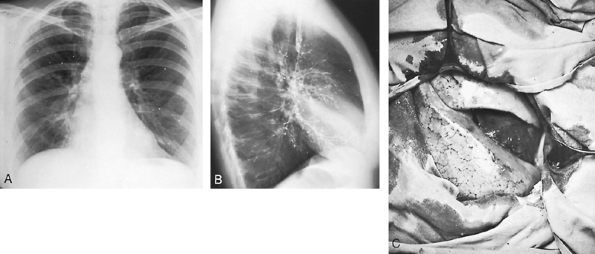 |
Fig. 86-10. A, B. Radiographs of a patient with bronchial compressive disease of the right middle lobe with complete atelectasis. Note obliteration of the heart border on the right side by the inflammatory process. C. Appearance of the right middle lobe at the time of operation. From Hood RM: Bacterial infections of the lungs. |
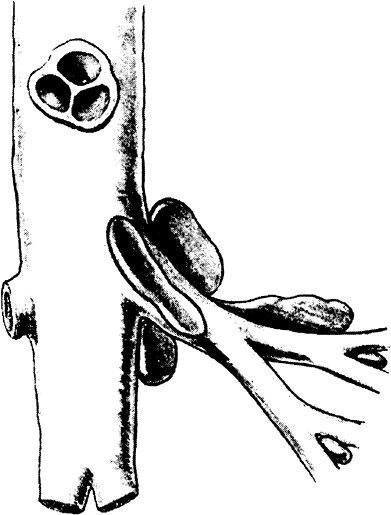 |
Fig. 86-11. Lateral views of the right middle lobe bronchus and the surrounding collar of lymph nodes. From Brock RC: The Anatomy of the Bronchial Tree. 2nd Ed. London: Oxford University Press, 1954, p. 122. With permission. |
P.1229
Diagnosis
The hallmarks of diagnosis are based on historical findings, endoscopy, and radiographic analysis. The majority of symptomatic patients have repeated episodes of infection, intermittent hemoptysis, and persistent atelectasis of the right middle lobe. The patients may have a history of years of repeated pulmonary infections. Endoscopic findings include bronchostenosis, tumor, and abnormal but nonspecific findings. A summary of seven series of 613 patients from the world literature reported by Wagner and Johnson (1983) showed 38% with stenosis or tumor and 17% with abnormal but nonspecific changes. Forty-five percent of this group had normal findings.
Before 1985, bronchograms were the standard method by which the diagnosis was made. CT scanning is now the preferred imaging modality. Findings include evidence of bronchostenosis, lobar collapse, inflammatory changes, and bronchiectasis.
Management of the Right Middle Lobe Syndrome
Patients who have repeated episodes of infection with lobar collapse and evidence of bronchostenosis, tumor, or obstruction from enlarged lymph nodes are best treated by surgical resection. If no endobronchial obstruction is present, the patient can generally be treated medically. Patients with diminished volume in their middle lobe who remain asymptomatic can be treated medically.
Broncholithiasis
Broncholithiasis is an uncommon pulmonary problem that may present with life-threatening complications. It is generally defined as an isolated area of bronchial compressive disease. The name implies that at least a portion of a calcified lymph node has eroded into the lumen of a bronchus. In general, as pointed out by Hood (1994a), this is considered to be a dynamic process with a spectrum of presentations.
According to Trastek and associates (1985), the spectrum of presentations includes: (a) erosion of a calcified lymph node into the lumen of a bronchus producing a broncholith, (b) distortion or partial obstruction of the tracheobronchial tree by calcified peribronchial lymph nodes, and (c) simulation of a cancer. To these must be added the occurrence of varying degrees of hemoptysis and the rare occurrence of erosion into other adjacent structures.
The pathogenesis of broncholithiasis is thought to be caused by the tissue response to a healing granulomatous inflammation as noted by Trastek and colleagues (1985). The most frequently involved diseases are histoplasmosis and tuberculosis. After spread to the central lymph nodes from the pulmonary parenchyma, calcium salts are deposited in the nodes during the healing process. Because of the dynamics of respiration, these nodes may erode into the tracheobronchial tree. They may likewise erode into adjacent organs, such as the esophagus or pulmonary vascular tree.
The majority of patients have characteristic cough with sputum production, hemoptysis, fever, and chills. Broncholithiasis may present as massive hemoptysis or as an esophagobronchial fistula. An occasional patient may cough up part of broncholithic stones.
The diagnosis should be suspected on routine chest radiography by the presence of centralized or infiltrating calcified lymph nodes or tracheobronchial distortion. CT scanning confirms these observations.
Endoscopic findings consist of tracheobronchial distortion, inflammation, a visible broncholith, bleeding, and inflammation. An occasional patient may have endoscopic findings of a fistula in either the esophagus or the tracheobronchial tree. Trastek and associates (1985) note that a tracheoesophageal fistula can be confirmed by contrast swallow.
According to Trastek and colleagues (1985), indications for surgery include intractable cough, recurrent hemoptysis, chronic infection resulting from bronchostenosis, or a secondary esophagobronchial fistula. The presence of a calcified node alone does not warrant surgery. Goals of treatment should be removal of all offending calcification and irreversibly damaged bronchi or lung, along with conservation of as much normal pulmonary parenchyma as possible. Because the tracheobronchial obstruction is frequently associated with postoperative pneumonitis, lung abscess, or bronchiectasis, resection rather than broncholithectomy is often required.
P.1230
At surgery, the calcified lymph nodes and subsequent intense inflammatory response make dissection extremely difficult and potential intraoperative complications of hemorrhage and esophageal perforation possible. Proximal control of the pulmonary artery should be obtained early, before beginning dissection in the area of calcified nodes. At times it is prudent to incise the capsule of the node and to curettage its contents to avoid injury to adjacent structures.
The extent of surgery depends on the anatomy, presence of calcified nodes, and extent of pulmonary parenchymal destruction. Ideally, an endoscopic broncholithectomy is the treatment of choice, but frequently is not possible. I have used successfully the yttrium-aluminum-garnet laser in two patients who were poor candidates for open surgery. However, a thoracotomy is generally required with broncholithectomy and removal of all damaged pulmonary parenchyma.
Trastek and associates (1985) reported on 52 patients with broncholithiasis. Forty patients were treated with thoracotomy. In this group, broncholithectomy was achieved in all patients and 32 required pulmonary resection of various types. In the bronchoscopy group, success was achieved in eight patients, with three requiring thoracotomy. Postoperative complications developed in 12.8% of the thoracotomy group and 37.5% of the bronchoscopy group. One postoperative death occurred. They concluded that broncholithectomy by way of thoracotomy is the preferred method of management. Resection should be conservative, but removal of all diseased pulmonary parenchyma should be included.
Sclerosing Mediastinitis
Sclerosing mediastinitis is an uncommon manifestation of a bronchocompressive disorder but can have devastating consequences. Although it may result from any number of causes, it most frequently follows infection with Histoplasma capsulatum. As I have noted, the most frequent malignant cause is Hodgkin's disease. The other causes of granulomatous mediastinitis with fibrosis are listed in Table 86-15.
For purposes of this chapter, the discussion is limited to sclerosing mediastinitis secondary to H. capsulatum and mediastinal granuloma. The inability to grow the microorganism from biopsy specimens has led to the conclusion that this severe complication is not a result of active foreign proliferation but a hypersensitive reaction to a healed infection. The delayed hypersensitivity results from the intense inflammation in parenchymal foci and lymph nodes, leading to caseous necrosis. Healing occurs by encapsulation and an intense fibrous process.
This extensive fibrotic process may result in severe complications. It is the most common cause of benign superior vena caval syndrome. Involvement of the tracheobronchial tree can result in stenosis at all levels of the airway. In addition, esophageal obstruction and esophagorespiratory fistulae have been reported. The most common symptoms are dyspnea, hemoptysis, postobstructive pneumonia, and superior vena caval syndrome.
Mathisen and Grillo (1992) reported on 20 patients, 18 of whom underwent complex tracheobronchial procedures. They stressed the tremendous surgical challenges that this entity presented because of the intense inflammatory lung response. They had three fatalities in this group of patients. Surgeons who undertake to treat this condition should be aware of the technical challenges and the potential for high morbidity and potential mortality. Mathisen and Grillo (1992) emphasized the need for resection for large asymptomatic mediastinal granulomas before the process of sclerosing mediastinitis develops.
Inflammatory Lymphadenopathy
Enlargement of mediastinal and bronchial lymph nodes may result in a bronchocompressive disorder. This is most frequently associated with tuberculosis, histoplasmosis, and sarcoidosis. This is particularly common in children with tuberculosis that may result in significant respiratory distress. This process has been referred to as tuberculosis lymph node compression syndrome. Treatment consists of antibiotic medication. In an occasional patient, surgical resection of the compressive nodes may be required. Worthington and co-workers (1993) have suggested that when acute airway obstruction occurs, airway decompression may be obtained by incision and curettage of the involved lymph nodes. This precludes major complications when the excision of the lymph node is difficult. Histoplasmosis and sarcoid can likewise cause tracheal, lobar, and segmental compression by enlargement of adjacent lymph nodes, resulting
P.1231
in a bronchocompressive disorder. Discussions of the effect of histoplasmosis have been previously mentioned. Sarcoid frequently responds to corticosteroid therapy.
Table 86-15. Etiologic Factors in Granulomatous Mediastinitis with Fibrosis | ||
|---|---|---|
|
Mediastinal Tumors
Mediastinal cysts and neoplasms frequently cause respiratory obstruction in children but rarely in adults. A bronchial or an esophageal cyst may occasionally occlude either the main bronchus or the trachea. The infant may present with severe respiratory distress and require urgent surgical intervention. Azizkhan and associates (1985) found that of 50 children with mediastinal tumors, 9 had significant symptoms of tracheobronchial compression and all 9 presented with marked obstruction and required surgical intervention.
In adults, bronchial or tracheal obstruction may occasionally occur from malignant neoplasms. This obstruction is most frequently due to bronchial carcinoma occluding a major bronchus by extrinsic compression or due to metastatic lymph node disease. In adults, lymphomas and small cell lung cancer also can cause tracheobronchial obstruction, resulting in various degrees of respiratory distress.
MISCELLANEOUS CONDITIONS
Esophageal Hiatal Hernia
In an occasional patient, a large paraesophageal hiatal hernia can cause tracheobronchial obstruction of the left main-stem bronchus, resulting in significant tracheobronchial compression with significant shortness of breath and occasional respiratory distress. Relief of the obstruction by surgical correction of the hiatal hernia is the method of choice.
Acquired Aortic Disease
Traumatic false aneurysms of the descending thoracic aorta and acquired descending thoracic aortic aneurysms can cause significant respiratory compromise by extrinsic compression of the left main-stem bronchus. This may result in symptoms of cough, wheezing, dyspnea, and hemoptysis. The diagnosis is suspected on chest radiography by enlargement of the mediastinum. CT scan, magnetic resonance imaging (MRI), and aortography confirm the diagnosis. Resection of the aneurysm results in relief of symptoms.
Primary Cardiovascular Disease
Table 86-1 lists some of the cardiac and vascular abnormalities that compress the trachea or main-stem bronchi. These abnormalities are frequently a manifestation of airway compression without a history of cardiac or vascular disease. An enlarged left atrium from either acquired mitral valve disease or congenital heart disease can compress or displace the left main-stem bronchus. In addition, varieties of vascular rings can cause respiratory obstruction. These include double aortic arch and a right descending thoracic aorta with a left ligamentum arteriosum. These conditions and other vascular rings are discussed in Chapter 79.
REFERENCES
Abati A, et al: Chronic granulomatous disease of childhood: respiratory cytology. Diagn Cytopathol 15:98, 1996.
Abramson SL: Recombinant human interferon-gamma (rIFN-gamma) and interleukin-4 (rIL-4) regulate gene expression of several phagocytic oxidase components. Clin Res 38:236A, 1990.
Annest LS, Kratz JM, Crawford FA Jr: Current results of treatment for bronchiectasis. J Thorac Cardiovasc Surg 83:546, 1982.
Azizkhan RG, et al: Life-threatening airway obstruction as a complication of mediastinal masses in children. J Pediatr Surg 20:816, 1985.
Barker AF: Bronchiectasis: Semin Thorac Cardiovasc Surg 7:112, 1995.
Blades B, Dugan D: Pseudobronchiectasis. J Thorac Surg 13:40, 1944.
Boyden EA: Segmental Anatomy of the Lungs. New York: McGraw-Hill, 1955.
Brock RC: The Anatomy of the Bronchial Tree. 2nd Ed. London: Oxford University Press, 1954.
Brock RC, Cann RJ, Dickinson JR: Tuberculous mediastinal lymphadenitis in childhood; secondary effects on the lungs. Guy Hosp Rep 87:295, 1937.
Crouch JD, Keagy BA, Delany DJ: Pigtail catheter drainage in thoracic surgery. Am Rev Respir Dis 136:174, 1987.
Culiner MM: The right middle lobe syndrome, a non-obstructive complex. Dis Chest 50:57, 1966.
Dogan R: Surgical treatment of bronchiectasis: a collective review of 487 cases. Thorac Cardiovasc Surg 37:183, 1989.
Ferguson TB, Burford TH: The changing pattern of pulmonary suppuration: surgical implications. Dis Chest 53:396, 1968.
Geppert EF: Lung abscess and other subacute pulmonary infections. In Niederman MS, Sacosi GA, Glassroth J (eds): Respiratory Infections. Philadelphia: WB Saunders, 1994.
Graham EA, Burford TH, Mayer JH: Middle lobe syndrome. Postgrad Med 4:29, 1948.
Hodder RV, Cameron R, Todd TRJ: Bacterial infections. In Pearson FG, et al (eds): Thoracic Surgery. New York: Churchill Livingstone, 1995.
Hood RM: Bronchial compressive diseases. In Shields TW (ed): General Thoracic Surgery. 4th Ed. Baltimore: Williams & Wilkins, 1994a.
Hood RM: Bacterial infections of the lungs. In Shields TW (ed): General Thoracic Surgery. 4th Ed. Baltimore: Williams & Wilkins, 1994b.
Hovelacque A, Monod O, Eurard H: The Thorax. Anatomie. Paris: Medico-Chirurgicale, 1937.
International Chronic Granulomatous Disease Cooperative Study Group: A controlled trial of interferon gamma to prevent infection in chronic granulomatous disease. N Engl J Med 324:409, 1991.
Lindskog GE: Bronchiectasis revisited. Yale J Biol Med 59:41, 1986.
Lindskog GE, Spear HC: Middle lobe syndrome, a non-obstructive complex. Dis Chest 50:57, 1966.
Marchevsky AM, Kaneko M: Surgical Pathology of the Mediastinum. 2nd Ed. New York: Raven, 1992.
Margolis DM, et al: Trimethoprim-sulfamethoxazole prophylaxis in the management of chronic granulomatous disease. J Infect Dis 162:723, 1990.
Mathisen DJ, Grillo HC: Clinical manifestation of mediastinal fibrosis and histoplasmosis. Ann Thorac Surg 54:1053, 1992.
Parker LA, et al: Percutaneous small bore catheter drainage in the management of lung abscesses. Chest 92:213, 1987.
Paulson DL, Shaw RR: Chronic atelectasis and pneumonitis of the middle lobe. J Thorac Surg 18:747, 1949.
Pogrebniak HW, et al: Surgical management of pulmonary infections in chronic granulomatous disease of childhood. Ann Thorac Surg 55:844, 1993.
P.1232
Rice TW, Ginsberg RJ, Todd TR: Tube drainage of lung abscesses. Ann Thorac Surg 44:356, 1987.
Roback SA, et al: Chronic granulomatous disease of childhood: surgical considerations. J Pediatr Surg 6:601, 1971.
Sanderson JM, et al: Bronchiectasis: results of surgical and conservative management. A review of 393 cases. Thorax 29:407, 1974.
Sealy WC, Bradham RR, Young WG Jr: The surgical treatment of multisegmental and localized bronchiectasis. Surg Gynecol Obstet 123:80, 1966.
Temeck BK, et al: Thoracotomy for pulmonary mycoses in non-HIV-immunosuppressed patients. Ann Thorac Surg 58:333, 1994.
Trastek VF, et al: Surgical management of broncholithiasis. J Thorac Cardiovasc Surg 90:842, 1985.
vanSonnenberg E, et al: Lung abscess: CT-guided drainage. Radiology 178: 347, 1991.
Wagner RB, Johnson MR: Middle lobe syndrome. J Thorac Surg 35:679, 1983.
Weening RS, Kabel P, Pijman P: Continuous therapy with sulfamethoxazole-trimethoprim in patients with chronic granulomatous disease. J Pediatr Surg 103:127, 1983.
Weissberg D: Percutaneous drainage of lung abscess. J Thorac Cardiovasc Surg 87:308, 1984.
White DA: Pulmonary infection in the immunocompromised patient. Semin Thorac Cardiovasc Surg 7:78, 1995.
Wiedemann HP, Rice TW: Lung abscess and empyema. Semin Thorac Cardiovasc Surg 7:119, 1995.
Worthington MG, et al: Surgical relief of acute airway obstruction due to primary tuberculosis. Ann Thorac Surg 56:1054, 1993.
Reading References
Agasthian T, et al: Surgical management of bronchiectasis. Ann Thorac Surg 62:976, 1996.
Ashour M: Hemodynamic alternatives in bronchiectasis: a base for a new subclassification of the disease. J Thorac Cardiovasc Surg 112:328, 1996.
Cole FH, et al: Management of broncholithiasis: is thoracotomy necessary? Ann Thorac Surg 42:225, 1986.
Dines DR, Bernatz PE, Pairolero PC: Mediastinal granuloma and fibrosing mediastinitis. Chest 73:320, 1979.
Ferguson TB, Burford TH: Mediastinal granuloma. Ann Thorac Surg 1:125, 1965.
Harper RR, Condon WB, Wierman WH: Middle lobe syndrome. Arch Surgery 61:696, 1950.
Inners CR, et al: Collateral ventilation and the middle lobe syndrome. Am Rev Respir Dis 118:305, 1978.
Kwon KY, et al: Middle lobe syndrome: a clinicopathological study of 21 patients. Hum Pathol 26:302, 1995.
McLean TR, Beall AC, Jones JW: Massive hemoptysis due to broncholithiasis. Ann Thorac Surg 52:1173, 1991.
Saha SP, et al: Middle lobe syndrome: diagnosis and management. Ann Thorac Surg 33:28, 1980.
EAN: 2147483647
Pages: 203